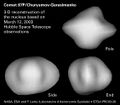Astronomy:Kepler-296e
| Discovery | |
|---|---|
| Discovery site | Kepler Space Observatory |
| Discovery date | 2014 |
| Transit | |
| Orbital characteristics | |
| 0.17400 AU (26,030,000 km) | |
| Eccentricity | <0.33[4] |
| Orbital period | 34.14234700 d |
| Inclination | 89.950 |
| Star | Kepler-296 |
| Physical characteristics | |
| Mean radius | 1.530 R⊕ [4] |
| Physics | 267 K (−6 °C; 21 °F) |
Kepler-296e (also known by its Kepler Object of Interest designation KOI-1422.05) is a confirmed super-Earth exoplanet orbiting within the habitable zone of Kepler-296. The planet was discovered by NASA's Kepler spacecraft using the transit method, in which the dimming effect that a planet causes as it crosses in front of its star is measured. NASA announced the discovery of the exoplanet on 26 February 2014.[1]
Characteristics
Kepler-296e was assumed to be a super-Earth with a radius 1.75 times that of Earth. A more revised estimate puts the planet at 1.53 Earth-radii. The planet orbits Kepler-296 once every 34.1 days at a semimajor axis distance of 0.169 AU.[4] It would have a mass of 4.52 Earth masses, with the higher-than-Earth density suggested by exoplanetkyoto.[5] With an Earth-like density, the mass would be 3.58 Earth masses. The planet's equilibrium temperature is 267 K (–6 °C; 21 °F), much higher than that of Earth.
Habitability
The planet was announced as being located within the habitable zone of Kepler-296. In this region, liquid water could exist on the surface of the planet.[6] It is likely rocky, with its relatively low radius, in contrast to f, which is larger.[4][6] As of 2017, with an ESI of 0.85, it is the fifth-most Earth-like planet after Kepler-438b, TRAPPIST-1 d, and two Gliese-designated planets, GJ 3323 b and GJ 273 b, which were both discovered in 2017.[7] The planet receives 1.4 times the Earth's solar flux, putting it well within the habitable zone and just barely beyond the runaway G line.[7][8] According to Kopparapu et. al (2013), the planet is within the most conservative boundaries of the habitable zone.[9] However, it has an eccentric orbit,[4][10] with a maximum eccentricity of 0.33 to a confidence of 3-sigma.[4] The planet's equilibrium temperature varies depending on its albedo: for a non-tidally locked planet with an Earth-like albedo of 0.3, it is 234 K (–39 °C; –38 °F), and for a Venus-like albedo of 0.7, it is 189 K (–84 °C; -119 °F). For a tidally locked planet with an Earth-like albedo of 0.3, the equilibrium temperature is 278 K (5 °C; 41 °F).[5]
Tidal locking
According to,[11] an Earth-size planet with eccentricity <0.1, no moons, and no obliquity orbiting at the Earth boundary within the habitable zone is tidally locked around a star with a mass of <0.42 solar masses (~M2 or later). When the Solar System is used as a yardstick, then the limit is 0.72 solar masses (~K3-4 or later). However, the orbit of planet e, is likely more eccentric than the modeled fictional planet, so the planet may not have had enough time to tidally lock.[4][10]
See also
- Kepler-62e and f
References
- ↑ 1.0 1.1 Staff (26 February 2014). "715 Newly Verified Planets More Than Triples the Number of Confirmed Kepler Planets". NASA. http://kepler.nasa.gov/news/nasakeplernews/index.cfm?FuseAction=ShowNews&NewsID=324.
- ↑ Lissauer, Jack J. (25 February 2014). "Validation of Kepler's Multiple Planet Candidates. II: Refined Statistical Framework and Descriptions of Systems of Special Interest". The Astrophysical Journal 784 (1): 44. doi:10.1088/0004-637X/784/1/44. Bibcode: 2014ApJ...784...44L. https://archive.org/details/arxiv-1402.6352.
- ↑ Rowe, Jason F. (2014). "Validation of Kepler's Multiple Planet Candidates. III: Light Curve Analysis & Announcement of Hundreds of New Multi-planet Systems". The Astrophysical Journal 784 (1): 45. doi:10.1088/0004-637X/784/1/45. Bibcode: 2014ApJ...784...45R.
- ↑ 4.0 4.1 4.2 4.3 4.4 4.5 4.6 Barclay, Thomas; Quintana, Elisa V; Adams, Fred C; Ciardi, David R; Huber, Daniel; Foreman-Mackey, Daniel; Montet, Benjamin T; Caldwell, Douglas (2015-08-04). "The Five Planets in the Kepler-296 Binary System all orbit the Primary: A Statistical and Analytical Analysis". The Astrophysical Journal 809 (1): 7. doi:10.1088/0004-637X/809/1/7. Bibcode: 2015ApJ...809....7B. https://iopscience.iop.org/article/10.1088/0004-637X/809/1/7#apj515650s5.
- ↑ 5.0 5.1 "Kepler-296 e". http://www.exoplanetkyoto.org/exohtml/Kepler-296_e.html.
- ↑ 6.0 6.1 "New Study Reassesses Habitability of Exoplanets Around Multiple Star Systems - AmericaSpace" (in en-US). 2015-05-25. https://www.americaspace.com/2015/05/24/new-study-reassesses-habitability-of-exoplanets-around-multiple-star-systems/.
- ↑ 7.0 7.1 "PHL @ UPR Arecibo – the Habitable Exoplanets Catalog". https://phl.upr.edu/the-habitable-exoplanets-catalog.
- ↑ "The Five Planets in the Kepler-296 Binary System All Orbit the Primary: A Statistical and Analytical Analysis". https://www.ipac.caltech.edu/publication/2015ApJ...809....7B.
- ↑ "Kepler-296 e". http://www.exoplanetkyoto.org/exohtml/Kepler-296_e.html.
- ↑ 10.0 10.1 Huffman, Darrell. "Gravity Simulator | Kepler-296 - System With 5 Exoplanets" (in en). https://gravitysimulator.org/exoplanets/kepler-296-system-with-5-exoplanets.
- ↑ Barnes, Rory (2017-12-01). "Tidal locking of habitable exoplanets" (in en). Celestial Mechanics and Dynamical Astronomy 129 (4): 509–536. doi:10.1007/s10569-017-9783-7. ISSN 1572-9478. Bibcode: 2017CeMDA.129..509B.
External links
- NASA – Kepler Mission.
- NASA – Kepler Discoveries – Summary Table.
- NASA – Kepler-296e at The NASA Exoplanet Archive.
- NASA – Kepler-296e at The Exoplanet Data Explorer.
- NASA – Kepler-296e at The Extrasolar Planets Encyclopaedia.
- Habitable Exolanets Catalog at UPR-Arecibo.
Coordinates: ![]() 19h 06m 9.60s, +49° 26′ 14.37″
19h 06m 9.60s, +49° 26′ 14.37″
 |






